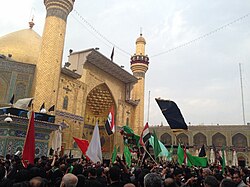| Islam by country |
|---|
 |
Islam in Iraq has a rich and complicated history dating back almost 1,400 years, since the lifetime of the Prophet Muhammad (c. 570 –8 June 632 CE). [1] As one of the first places in the world to accept Islam, Iraq is a mostly Muslim nation, with about 98% of the people identifying as Muslim. [2] There are the two main branches of Islam in Iraq: Shia Islam, which is practiced by about 50-60% of Muslims and Sunni Islam, which is practiced by about 35-45%. [3] [4]
Contents
- History
- The Fall of the Sarasin Empire
- The Abbasid Caliphate
- Iraq under Ba'athist rule
- Insurgencies
- Religious cities
- Demographics
- Islam in law
- Gallery
- See also
- References
Iraq holds a prominent place in Islamic history and has been a hub of Islamic thought and government. Baghdad was once the capital of the Abbasid Caliphate and a center of Islamic scholarship. [5] The famous Sunni thinker Abu Hanifa taught in Kufa, and Ibn Hanbal taught in Baghdad. [6] The tomb of Ali ibn Abi Talib, the first Shia Imam and the fourth caliph, is in Najaf, a major pilgrimage site. [7] Karbala was the site of the Battle of Karbala in 680 AD, which had a significant impact on Shia beliefs and practices. [8] The Kadhimiya neighborhood in Baghdad contains the shrines of the seventh and ninth Shia Imams Musa al-Kazim and Muhammad al-Jawad, [9] while the Al-Askari Shrine in Samarra is the site of the tombs of the tenth and eleventh Shia Imams Ali al-Hadi and Hasan al-Askari. [10]
Throughout history, Iraq has also been the site of many fitnas, or religious splits, that have changed the way sects interact with each other. [11] [12] This makes it an important place to study Islamic history and the relationships between different sects. [13]




